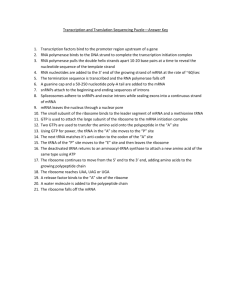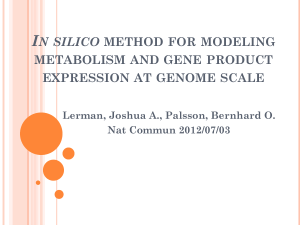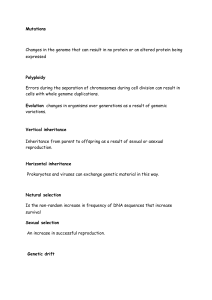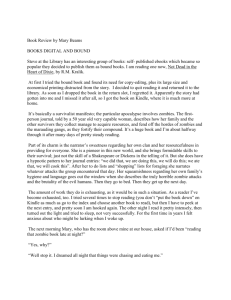Additional file 1
advertisement
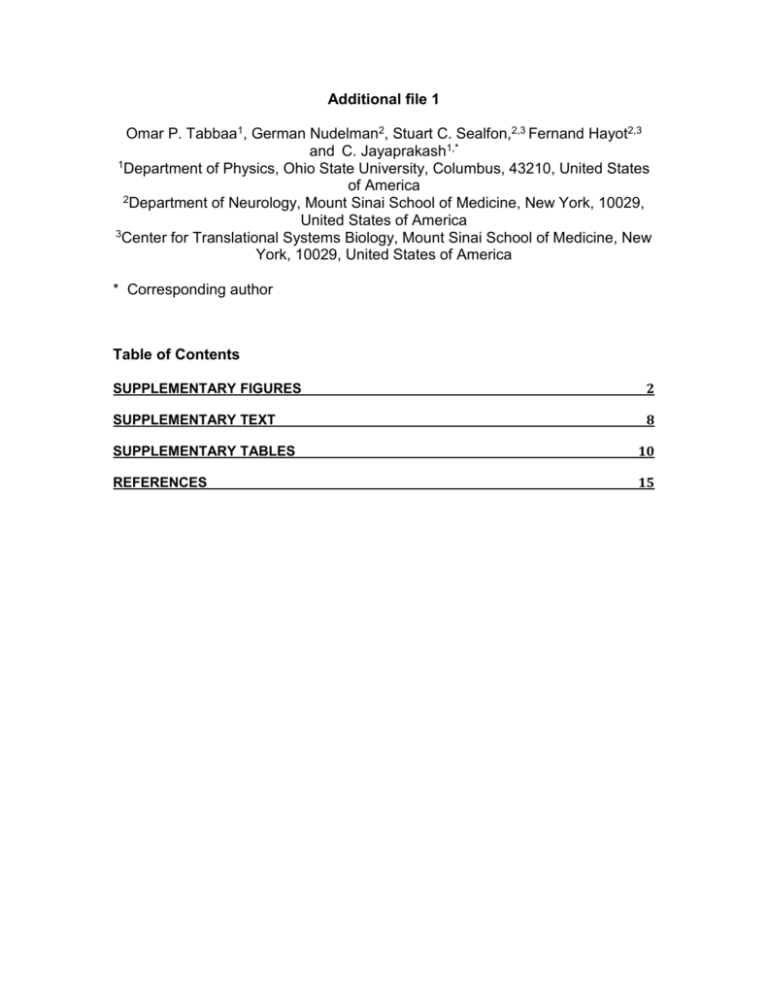
Additional file 1 Omar P. Tabbaa1, German Nudelman2, Stuart C. Sealfon,2,3 Fernand Hayot2,3 and C. Jayaprakash1,* 1Department of Physics, Ohio State University, Columbus, 43210, United States of America 2Department of Neurology, Mount Sinai School of Medicine, New York, 10029, United States of America 3Center for Translational Systems Biology, Mount Sinai School of Medicine, New York, 10029, United States of America * Corresponding author Table of Contents SUPPLEMENTARY FIGURES 2 SUPPLEMENTARY TEXT 8 SUPPLEMENTARY TABLES 10 REFERENCES 15 Supplementary Figures 1 0.9 0.8 0.7 S(t) 0.6 0.5 0.4 0.3 0.2 0.1 0 2 4 6 8 10 12 14 16 18 Time (hrs) Figure S1: Plot of S(t), a measure of the relative contributions of autocrine and paracrine signaling, as a function of time. Let B*(t) and B(t) denote the average number of bound IFNAR on cells with and without IFN-β mRNA at time t respectively. The former is determined by both autocrine and paracrine signaling while the latter arises from paracrine signaling only. As a quantitative measure of their relative importance we have defined S(t) = (B*(t) - B(t))/(B*(t) +B(t)). When the signaling is all autocrine (B(t)=0) S(t) equals 1, for equal contributions from autocrine and paracrine signaling (B*(t)=2B(t)) S(t) equals 1/3, and for purely paracrine signaling (B*(t)=B(t)) S(t) equals 0. We see that after about 6 hours paracrine signaling dominates. B A C Figure S2: Spatial distribution of bound IFNAR receptors in all cells. The distributions at (A) 6 hours (B) 9 hours and (C) 11 hours post infection are displayed. The colors indicate the range of IFNAR numbers: black denotes bound IFNAR numbers fewer than 250 per cell, green a number between 250 and 500, orange a number greater than 500. At early times (less than 6 hours) less than 1% of cells display bound receptor numbers fewer than the threshold and the majority of cells that have greater than the threshold are IFN-β producing (see Figure 4 in main text) reflecting the dominate role of autocrine signaling. The number of cells with bound receptor numbers larger than the threshold values progressively increases to a homogenous state of all cells having greater than the threshold number of bound receptors as the paracrine signaling becomes the dominate type of signaling at later times (approximately 11 hours). A B 0.04 0.05 0.0014 0.035 0.0012 0.04 0.001 0.02 0.015 Fraction of Cells 0.025 Fraction of Cells Fraction of Cells 0.03 0.03 0.0008 0.0006 0.0004 0.0002 0.02 0 3000 4000 5000 6000 7000 8000 9000 10000 11000 Number of RIG-I 0.01 0.01 0.005 0 0 0 500 1000 1500 2000 2500 Number of RIG-I 3000 3500 4000 0 2000 4000 6000 8000 10000 Number of RIG-I Figure S3: The RIG-I copy number distribution at (A) 6 hours and (B) 11 hours post infection. The long (approximately 3-hour) degradation rate of the RIG-I protein allows accumulation in cells in which the gene is induced early. This leads to a long tail (RIG-I number greater than 3000) at 11 hours shown in the inset that accounts for a sixth of the cells. B A 1.2 0.09 0.08 0.8 0.06 Fraction of Cells Average DDX58 Production Rate 1 0.07 0.05 0.04 0.6 0.4 0.03 0.02 0.2 0.01 0 0 0 200 400 600 Number of Bound IFNAR 800 1000 3 4 5 6 7 8 9 10 11 Time (hrs) Figure S4: (A) Time averaged DDX58 transcription rate as a function of the number of bound IFNAR. This is obtained by deriving an effective deterministic equation for DDX58 transcription from the reactions in Supplementary Table S2. (B) Time evolution of the fraction of cells with bound IFNAR between 200 and 600 (the threshold value for half-maximum rate of DDX58 gene induction is 475). The green points correspond to cells with IFN-β mRNA and black points to those without. The fraction of cells with substantial bound IFNAR increases earlier for cells with IFN-β mRNA in contrast to cells without, reflecting the importance of autocrine signaling at early times between 5.5 and 6.5 hours. The fraction of cells with a bound IFNAR number between 200 and 600 decreases beyond 9 hours because the bound IFNAR number exceeds 600. 120 Induced Gene Fano Factor 100 80 60 40 20 0 2 4 6 8 10 12 14 16 18 Time (hrs) Figure S5: Dependence of the Fano factor of the induced gene (DDX58) on the activation rate of the IFNB1 gene. The black points denote the temporal variation of the Fano factor with the activation rate constant, cf in Supplementary Table S4, set equal to the original value used in the main text. The effect of increasing the activation rate three-fold from the original value (red points) and decreasing it three-fold (green points) is asymmetric. The change is minimal for the increase while the three-fold decrease delays the time at which the maximum occurs by more than 90 minutes. 140 Induced Gene Fano Factor 120 100 80 60 40 20 0 2 4 6 8 10 12 14 16 18 Time (hrs) Figure S6: The effect of the variation of the binding rate of IFN-β binding to a free IFNAR on the time variation of the Fano factor of the induced gene. The behavior when the binding rate, kb in Supplementary Table S4, is equal to the original value used in the main text is shown as black points. A four-fold increase in the binding rate with respect to the original value decreases the maximum Fano factor slightly but speeds up the approach to the steady-state value. When the binding rate is decreased four-fold the peak value is delayed but increased and the decay is considerably slower. Bound Receptor Distributions Fraction of Cells 0.8 0.6 0.4 0.2 0.0 0 200 400 600 800 Number of Bound Receptors Figure S7: The combined distributions of Figure 4 (panels A-C) of bound interferon receptors (IFNAR) for cells with and without IFN-β mRNA. For cells containing IFN-β mRNA (black border) and for cells with no IFN-β mRNA (blue border) plotted at 6 hours. The larger fraction of bound receptors in cells with IFN-β mRNA above 200 in comparison to cells without IFN-β mRNA (at 6 hours) indicates the importance of autocrine signaling at early times (4 – 6 hours post infection). The distribution of bound IFNAR at 11 hours post infection is displayed for cells with (red border) and for cells without (green border) IFN-β mRNA. Supplementary Text Text S1: Analytic Calculation for the Diffusion Time Step We provide a theoretical derivation of the numerical value of the time step, τ, for the diffusion of IFN-β used in the simulations. The probability of the protein being at the position (x, y) on the lattice at time t + τ obeys the discrete diffusion equation p P(x, y, t + τ) = (1 − p)P(x, y, t) + 4 [P(x + a, y, t) + P(x − a, y, t) + P(x, y + a, t) + P(x, y − a, t)]. This equation states that in a time τ the protein stays in the original position with probability (1 − p) chosen to be 1/2 or moves one step to the four nearest points with probability p/4 [1]. The spatial distance moved is the size of the box used in the simulations, 30 μm. We will obtain an expression for the effective diffusion constant from this equation and equate it to the value 10 μm2 /s for the IFN-β protein in the supernatant [2]. This allows us to determine τ. The expression for the diffusion constant is obtained by applying a Taylor series expansion in powers of a to Equation (1) and retaining the leading powers of space and time derivatives. We obtain ∂P ∂t = p a2 4τ ∇2 P . (2) This is the standard form of the diffusion equation in continuous space-time and allows one to immediately identify the diffusion constant D to be (1) p a2 4τ . Using the values given above we find τ = 11.25s the value used in our simulations. Supplementary Tables Table S1: Molecule The empty IFN-β gene The first stage of the assembled enhanceosome Abbreviation D Ds1 The second stage of the assembled enhanceosome Ds2 The third stage of the assembled enhanceosome Ds3 The enhanceosome without the activators Ds4 The activated IFN-β gene RIG-I mRNA RIG-I protein IFN-β mRNA IFN-β protein Free interferon receptor Bound interferon receptor DDX58 gene in the basal transcription state DDX58 gene in the enhanced transcription state Ds4* DDX58 RIG-I IFNβm IFNβ IFNAR IFNAR* G G* Table S1: The above table lists the molecule types used in our model and the respective abbreviations used in the text and the Tables. Table S2: Intracellular Reactions Description of Reaction First step in enhanceosome assembly Propensities Forward: k1eff 𝐷 Reverse: k −1 𝐷𝑠1 Ds2 Second step in enhanceosome assembly Forward: k1eff 𝐷𝑠1 Reverse: k −1 𝐷𝑠2 Ds3 Third step in enhanceosome assembly Forward: k1eff 𝐷𝑠2 Reverse: k −1 𝐷𝑠3 Ds4 Fourth step in enhanceosome assembly Forward: k1eff 𝐷𝑠3 k Reverse: 4−1 𝐷𝑠4 Activation/deactivation of IFN-β gene Basal transcription of DDX58 Enhanced transcription of DDX58 Degradation of DDX58 Forward: cf 𝐷𝑠4 Reverse: cb Ds4∗ keff 1 D Ds1 k−1 keff 1 Ds1 k−1 keff 1 Ds2 k−1 keff 1 Ds3 k−1 4 cf Ds4 klow DDX G→ Ds4∗ cb G + DDX58 high kDDX G∗ → G∗ + DDX58 δDDX DDX58 → ϕ cb (β IFNAR∗ )2 G G cb kRIG-I DDX58 → DDX58 + RIG-𝐼 δRIG-I RIG-𝐼 → keff IFN Ds4∗ → ∗ ϕ Ds4∗ + IFNβm δIFN IFNβm → ϕ ks IFNβm → IFNβ kb IFNβ + IFNAR kub IFNAR∗ k low DDX 𝐺 high k DDX G∗ δDDX 𝐷𝐷𝑋58 Activation/deactivation of Forward: cb (β IFNAR∗ )2 𝐺 DDX58 gene Reverse: cb G∗ Translation of RIG-I k RIG-I DDX58 Degradation of RIG-I δRIG-I RIG-𝐼 Transcription of IFN-β mRNA ∗ k eff IFN Ds4 Degradation of IFN-β mRNA Secretion of IFN-β δIFN IFNβm k s IFNβm Binding and Unbinding of Forward: k b IFNβ IFNAR IFN-β to the interferon Reverse: k ub IFNAR∗ receptors Table S2: The above table gives the reactions, reaction descriptions, and the propensites that determine the probability for the reaction to occur in our simulations. Table S3: Effective Rate Constants Definition eff k1 2 k1 (γ RIG-I)3 k1 + (forward rate of enhanceosome 10 10 1 + (γ RIG-I)3 assembly) high k low k DDX DDX (1 + η) (high transcription rate of DDX58 production) 3k IFN k IFN (β IFNAR∗ )4 k eff IFN + (rate of IFNβ production) 4 2 1 + (β IFNAR∗ )4 Table S3: The above table gives the effective rate constants for the forward rate of enhanceosme assembly (k1eff ), the high transcription rate of DDX58 production high (k DDX ), and the rate of IFN-β production (k eff IFN ). RIG-I and IFNAR* denote the corresponding number of molecules per cell. See the Methods section of the main text for an explanation of the effective rate constants. Table S4: Description of rate constant Variable name k1 Numerical Value k −1 5.46 ∗ 10−3 s −1 1 γ 5750 Number of bound IFNAR at which the DDX58 transcription rate is half maximum DDX58 degradation rate constant Activation rate of the IFNB1 gene Deactivation rate of the IFNB1 gene RIG-I translation rate constant k low DDX 1 β δDDX cf cb k RIG-I 0.005s−1 475 RIG-I degradation rate constant Maximum transcription rate of IFN-β mRNA δRIG-I k IFN Rate constant for the binding of IFN-β to a free IFNAR Rate constant for the unbinding of IFN-β from a bound IFNAR IFN-β secretion rate constant kb 10−4 s−1 1.5 ∗ 10−4 s −1 3 ∗ 10−5 s −1 1 s−1 262.33 10−4 s−1 1 −1 s 7.5 10−2 nM −1 s −1 k ub 10−3 s−1 ks Enhancement factor for DDX58 transcription η 1 −1 s 90 20 IFN-β mRNA degradation rate constant δIFN 10−4 s−1 Rate constant for a enhanceosome component binding Rate constant for a enhanceosome component unbinding RIG-I number when the enhancement component of the rate constant for a enhanceosome component binding is half maximum Basal transcription rate of DDX58 0.00136s −1 Table S4: The above table gives the rate constants and parameters used in our simulations. These numbers are based on estimates in previously published work and experimental data [2-7]. See the Methods section of the main text for more details. Table S5: Molecule DDX58 IFNβm IFNAR IFNAR* D Ds1 Ds2 Ds3 Ds4 Ds4* RIG-I IFNβ G G* Density of Cells Multiplicity of Infection Volume of a Cell Initial Condition Poisson distribution with a mean of 50 0 1000 0 1 0 0 0 0 0 1906 0 1 0 5 ∗ 106 cells/mL 0.5 1.4 ∗ 104 𝜇𝑚3 Table S5: The above table gives the initial number of molecules per dendritic cell, the density of cells used in the simulations, the multiplicity of infection, and the volume of each cell. These numbers are based on estimates in previously published work and experimental data [2-7]. See the Methods section of the main text for more details. References 1. Gardiner CW (2004) The Random Walk in One Dimension. In Handbook of stochastic methods (pp. 70-73). Berlin: Springer. 2. Shimoni Y, Nudelman G, Hayot F, and Sealfon SC: Multi-scale stochastic simulation of diffusion-coupled agents and its application to cell culture simulation. PLoS One 2011, 6:e29298-e29298 3. Hu J, Nudelman G, Shimoni Y, Kumar M, Ding Y, López C, Hayot F, Wetmur JG, and Sealfon SC: Role of Cell-to-Cell Variability in Activating a Positive Feedback Antiviral Response in Human Dendritic Cells. PLoS One 2011, 6: 1661-1664. 4. Coppey M, Berezhkovskii AM, Sealfon SC, and Shvartsman SY: Time and length scales of autocrine signals in three dimensions. Biophys J 2007, 93: 1917-1922. 5. Hu J, Iyer-Biswas S, Sealfon SC, Wetmur J, Jayaprakash C, and Hayot F: Power-laws in interferon-b mRNA distribution in virus-infected dendritic cells. Biophys J 2009, 97: 1984-1989. 6. Honda K, Yanai H, Negishi H, Asagiri M, Sato M, Mizutani T, Shimada N, Ohba Y, Takaoka A, Yoshida N, and Taniguchi T: IRF-7 is the master regulator of type-I interferon-dependent immune responses. Nature 2005, 434: 772-777.Munshi N, Agalioti T, Lomvardas S, Merika M, Chen G, and Thanos D: Coordination of a transcriptional switch by HMGI(Y) acetylation. Science 2001, 293:1133-1136. 7. Panne D, Maniatis T, and Harrison SC: An atomic model of the Interferon-β enhanceosome. Cell 2007, 129: 1111-1123.





